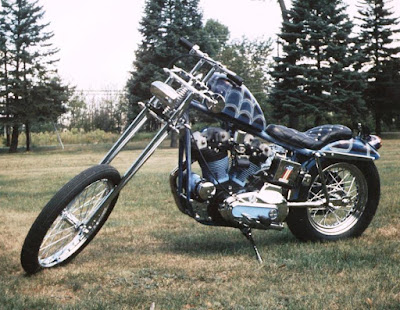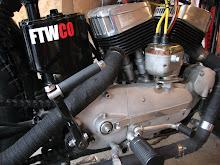50 Wt Oil = Caramel
I took the drain plug out, and I thought it was empty??? Huh? What the heck? Oh, there it is - all 4 quarts of oil took about 6 hours to drain. A small little string of oil just kept on and on near the end. No lie !
Krusty Khrome
Now I got this thing for a "crusty" early ironhead swingarm bike - with a slightly over stock or springer front end. Short rear fender (maybe with a steel tail-light hiked up?), peanut tank, flaking chrome, vintage seat, maybe a painted frame . . . A bike you wouldn't worry about leaving outside covered with tarp - with a log chain around it. I've got all these gross looking parts, been hauling around to swap meet after swap meet - can't hardly give 'em away - let's put 'em all on the same motorcycle. Never wash it (wouldn't want to rinse the grease out).
We've had this 1970 ironhead engine with peeling chrome that would make a good mill....
Tappet Weight
The LEFT tappet is lighter by about 1/2 oz. or almost 1 oz. total valve train weight(X 4ea) ...at 5000 rpms, that's a difference...more weight for the valve spring to push down - to hold the tappet on the cam...
1953 Harley KK Model (and some KRs) had hollow tappet adjusters too,
with a hole right down the middle.
NOTE: The RIGHT tappet is stock in Harley WL engines, and what makes it so heavy is that it's thicker, and solid steel. The LEFT tappet is standard on early 900 Sportster engines.
You can run the lighter tappets in WLs, K Models, whatever...they're dimensionally interchangeable, same length, diameter, etc. To most folks, ounces only matter at the post office, or your drug dealer, or the judge.
1965FLH
This motor is pretty much done. A couple things to check over before I give it back to my friend Chad, who I've been riding to Sturgis with the last few years. New lower end, dynamically balanced crankshaft, Kibblewhite valves, Rowe guides, bore job, pistons, lower Timken....all checked out. It'd better be good, since I'll be riding with him - and if anything happens - fingers get pointed !
'52K Update
My 1952 Model K is receiving a "refresher." I'm back to +.010 over pistons with these restored cylinders. Chad fixed some cooling fins, Hawbaker repaired a base, I did a new sleeve in one. My late and great acquaintance Mr. John Penner made this KHRM high desert pipe which I'll try and run with a factory, early XLCH single muffler. These K Models run sweet with Dellorto PHM38mm carburetors - so here's a new one for this thing. I'll probably sell off my ol' CV carb, old cylinders, some other junk I don't need, to fund my addiction. The magneto still throws a hot spark with little effort. More updates later . . .
Some Neat Bikes on Ebay Now . . .
This WLA. Unrestored condition with original paint from Russia and the USA.... It's just got the rustic vibe goin' on.
This knuckle is another one . . .
I really like this low Sportster . . .
Denzer !
This must be somewhere up above Milwaukee ? Clyde is still around too . . . don't know about the 1960 XLCH ? #highclearanceexhaust #hifiblue #shineyboots #clydedenzer #goodyeargrasshoppers #-60rims
One Fast Cookie
My inside cat, Elliott says, "Hey Rick, we gonna make your skillet cookie?"
He's a cool fella. The fastest cat I've ever had ! He's damn fast !
He's a cool fella. The fastest cat I've ever had ! He's damn fast !
Valves Overhead vs. Valves On-The-Side
A couple motors for Chad and Warren put to bed for the night. The Panhead has been a typical build, and we'll get the auto advance timer installed before the front head goes on. Make up a cloth covered hot wire. I'm tired, worked all weekend on stuff....
Sunday Work
... line-lapping these KHK cases yesterday after replacing the mainshaft race. Now it's nice and straight with the clutch gear(in the door). Cases are show polished.
Sailor's Morning . .
The calm before the blizzard. We've had a funky winter this year...no snow, very little ice, no ice riding, no snowmobiling, no ice fishing...kinda fartin' up the winter sports.
A couple small flurries....and a trip to the local coffee bar for a small one from Brazil.
As I drink my cafe' . . . I like this exhaust pipe. The KHRM came with this desert pipe.
A couple small flurries....and a trip to the local coffee bar for a small one from Brazil.
As I drink my cafe' . . . I like this exhaust pipe. The KHRM came with this desert pipe.
Yes on this one . . .
Photos stolen from BaRon's blog and DICE Magazine. This build is really neat - about everything about it - I like it a lot . . .
I like the front wheel, rear fender, frame molding, high shoulder rims, paint color, mural . . . it's just a bitchin' build. I might shorten the sissy bar and lean it back a bit...and ditch the CV carburetor for an SU or Linkert...but, hey - it's not my bike - and I don't think it's for sale - and if it was, I probably couldn't afford it. Hats off to one sweet ride.
Harley WR Racing Engine
I've been jammin' the last few weeks to get this WR engine done so I can deliver it to
The Mama Tried Motorcycle Show on Feb. 15-16 in Milwaukee. This particular engine has some documented race history with a top 5 finish in the early 1950s at the legendary Springfield Mile.
After repairing the engine cases, machining, measuring, etc. Almost every part on the engine has required attention. The motor was together when I received it, but the parts mirrored "swap meet specials" haphazardly assembled. The ball bearing construction appears easy to conquer...but now you're dealing with hand-press-fit on everything. It's very difficult to align the cam timing marks when each cam is pressed into position. I ended up "adding the pinion gear last" since it's slip fit, and the wide mark on the spline is at the same position as the timing mark, so you knew your position. So many particulars need addressed when assembling an engine of this nature. Basically, it's got to be perfect, or destroy shit on initial start up. This is the 5th ball bearing-type engine I've built (with dad too) - and we still spend about as much time reading, as we do building the motor.
The magneto is a horizontally mounted Wico Single Fire type unit. The ignition timing is best set by
location of the piston to TDC...then verify the timing actual timing mark on the flywheel. On the earlier WRs, once the gear cover is on...you can't change your timing from the outside, since the magneto is bolted solid to the case. No rotation. The Wico cap has a #1 which indicates the REAR(or #1 cylinder) and the spark plug wires must be installed correctly.
I updated the sprocket shaft seal (from the steel reverse thread seal) to a modern type rubber-lip seal. It required indicating the oem steel outside spacer to dead on a lathe, then turning a recess for the seal (for press fitment)and cutting a snap ring groove. The seal kit (from Colony) is the same as a Big Twin seal, since the sprocket shaft in a WR is the same diameter as a panhead....but instead, runs a large 25mm ID high load ball bearing. A #1205 ball bearing to be exact: 25mm x 52mm x 15mm Superblend-type bearing. This type bearing compensates for crankshaft deflection.
The Mama Tried Motorcycle Show on Feb. 15-16 in Milwaukee. This particular engine has some documented race history with a top 5 finish in the early 1950s at the legendary Springfield Mile.
After repairing the engine cases, machining, measuring, etc. Almost every part on the engine has required attention. The motor was together when I received it, but the parts mirrored "swap meet specials" haphazardly assembled. The ball bearing construction appears easy to conquer...but now you're dealing with hand-press-fit on everything. It's very difficult to align the cam timing marks when each cam is pressed into position. I ended up "adding the pinion gear last" since it's slip fit, and the wide mark on the spline is at the same position as the timing mark, so you knew your position. So many particulars need addressed when assembling an engine of this nature. Basically, it's got to be perfect, or destroy shit on initial start up. This is the 5th ball bearing-type engine I've built (with dad too) - and we still spend about as much time reading, as we do building the motor.
The magneto is a horizontally mounted Wico Single Fire type unit. The ignition timing is best set by
location of the piston to TDC...then verify the timing actual timing mark on the flywheel. On the earlier WRs, once the gear cover is on...you can't change your timing from the outside, since the magneto is bolted solid to the case. No rotation. The Wico cap has a #1 which indicates the REAR(or #1 cylinder) and the spark plug wires must be installed correctly.
I updated the sprocket shaft seal (from the steel reverse thread seal) to a modern type rubber-lip seal. It required indicating the oem steel outside spacer to dead on a lathe, then turning a recess for the seal (for press fitment)and cutting a snap ring groove. The seal kit (from Colony) is the same as a Big Twin seal, since the sprocket shaft in a WR is the same diameter as a panhead....but instead, runs a large 25mm ID high load ball bearing. A #1205 ball bearing to be exact: 25mm x 52mm x 15mm Superblend-type bearing. This type bearing compensates for crankshaft deflection.
The pinion side runs a #1204 Superblend type bearing.
20mm x 47mm x 14mm
All bearings require light press fit on shafts and case.
It's just fun times getting all this to fit the way it should...
The lower pump has been checked over, blasted, washed and inspected. I painted it my special cast iron gray, installed, with breather timed. I bumped the breather ahead 1 tooth, since the piston was already about 2" down in the cylinder before it started opening (via breather timing mark). By one tooth advanced, the breather window opens just after TDC - to get that crankcase evacuated of pressurized air a bit sooner. The cylinders had "hardened steel sleeves" installed sometime over the years. I had to purchase specific honing stones to straighten-out-the-tight-spots and generate a usable set of cylinders, since they are already oversized. To win races back in the 1950s, these engine builders used the largest valves, and largest bore sizes, and bent the rules to take wins. Unfortunately, the removal of all this metal leaves nothing behind for restoration. New guides, a couple valves, new springs, all shimmed and set for cam specifications. The cylinder/valve work on these flatheads is usually the most time consuming. It seems simple, but these motors will run and run while still way-out-of-specification. They're usually worn to epic levels. These things just keep on chugging - all the way to the flag !
Subscribe to:
Comments (Atom)


















































